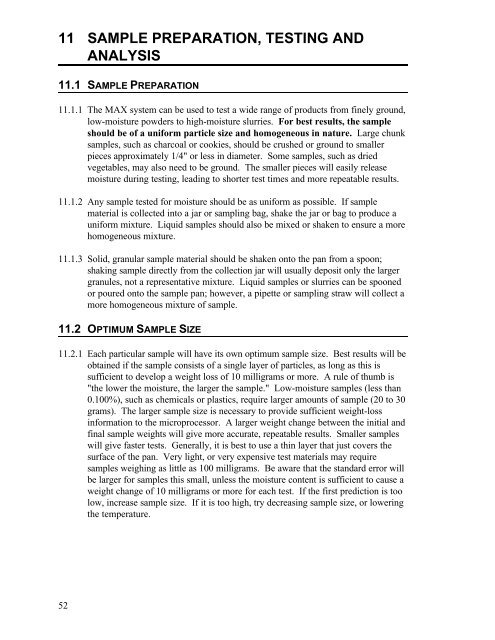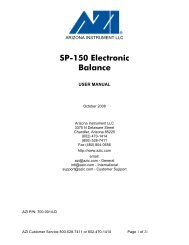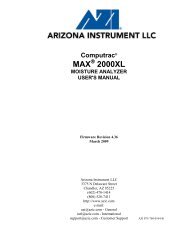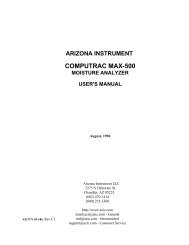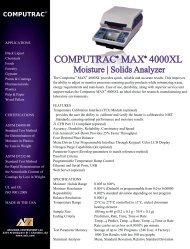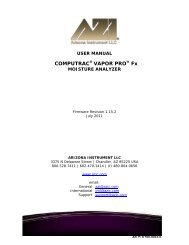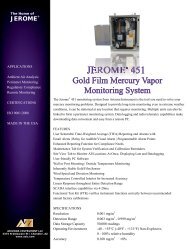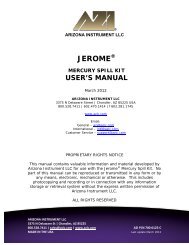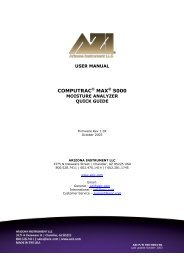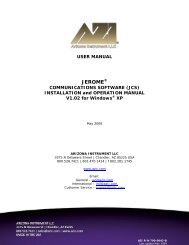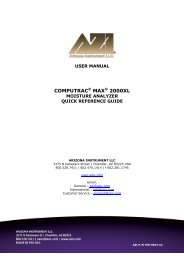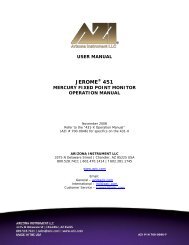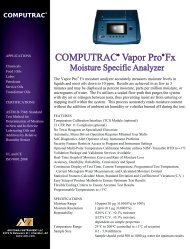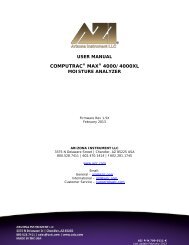Computrac MAX-1000 User's Manual - Arizona Instrument
Computrac MAX-1000 User's Manual - Arizona Instrument
Computrac MAX-1000 User's Manual - Arizona Instrument
You also want an ePaper? Increase the reach of your titles
YUMPU automatically turns print PDFs into web optimized ePapers that Google loves.
11 SAMPLE PREPARATION, TESTING ANDANALYSIS11.1 SAMPLE PREPARATION11.1.1 The <strong>MAX</strong> system can be used to test a wide range of products from finely ground,low-moisture powders to high-moisture slurries. For best results, the sampleshould be of a uniform particle size and homogeneous in nature. Large chunksamples, such as charcoal or cookies, should be crushed or ground to smallerpieces approximately 1/4" or less in diameter. Some samples, such as driedvegetables, may also need to be ground. The smaller pieces will easily releasemoisture during testing, leading to shorter test times and more repeatable results.11.1.2 Any sample tested for moisture should be as uniform as possible. If samplematerial is collected into a jar or sampling bag, shake the jar or bag to produce auniform mixture. Liquid samples should also be mixed or shaken to ensure a morehomogeneous mixture.11.1.3 Solid, granular sample material should be shaken onto the pan from a spoon;shaking sample directly from the collection jar will usually deposit only the largergranules, not a representative mixture. Liquid samples or slurries can be spoonedor poured onto the sample pan; however, a pipette or sampling straw will collect amore homogeneous mixture of sample.11.2 OPTIMUM SAMPLE SIZE11.2.1 Each particular sample will have its own optimum sample size. Best results will beobtained if the sample consists of a single layer of particles, as long as this issufficient to develop a weight loss of 10 milligrams or more. A rule of thumb is"the lower the moisture, the larger the sample." Low-moisture samples (less than0.100%), such as chemicals or plastics, require larger amounts of sample (20 to 30grams). The larger sample size is necessary to provide sufficient weight-lossinformation to the microprocessor. A larger weight change between the initial andfinal sample weights will give more accurate, repeatable results. Smaller sampleswill give faster tests. Generally, it is best to use a thin layer that just covers thesurface of the pan. Very light, or very expensive test materials may requiresamples weighing as little as 100 milligrams. Be aware that the standard error willbe larger for samples this small, unless the moisture content is sufficient to cause aweight change of 10 milligrams or more for each test. If the first prediction is toolow, increase sample size. If it is too high, try decreasing sample size, or loweringthe temperature.52


